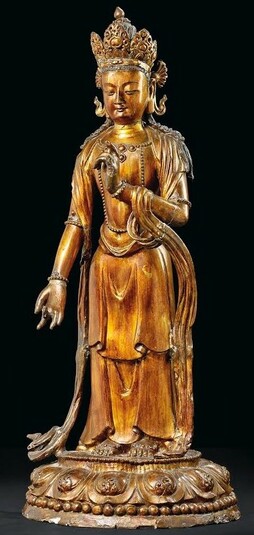
Item: Bodhisattva - (Male, Standing)
| Origin Location | China |
|---|---|
| Date Range | 1700 - 1799 |
| Lineages | Buddhist |
| Size | 92.08cm (36.25in) high |
| Material | Wood |
| Collection | Private |
Classification: Deity
Appearance: Peaceful
Gender: Male
Bodhisattva Figure (unidentified), likely from a set of the Eight Great Bodhisattva or a set of two intended to flank an image of Shakyamuni or Amitabha Buddha. (See a definition of the term Bodhisattva.
In Buddhist art terminology ‘bodhisattva’ is used to designate a male figure included as one of the realized (relating to the Bodhisattva levels of accomplishment) students of Shakyamuni Buddha based on the Mahayana Sutra literature. In art ‘bodhisattva’ is descriptive and synonymous with the term ‘peaceful appearance.’ In Theravada Buddhism the word ‘bodhisattva’ refers exclusively to Shakyamuni as a prince prior to his complete enlightenment under the bodhi tree.
There are different groupings of the more important of the bodhisattvas. In Tibetn, Himalayan and Chinese art, for paintings and sculpture, Manjushri, Lokeshvara and Vajrapani are a commonly found group based on the Mahayana Sutras and the later Kriya Tantra literature. Maitreya is particularly popular in Eastern Tibet and China in general. (See a list of the most common bodhisattva groups).
The group known as the Eight Great Bodhisattvas, including the three mentioned above, have in addition: Maitreya, Akashagarbha, Kshitigarbha, Samantabhadra and Nivarana-vishkhambhin. From this set, in China, there are four which are considered the 'Four Bodhisattvas of China' each with their own sacred maountain. For Lokeshvara it is Mount Puto, for Manjushri Wutaishan, for Samantabhadra Omeishan, and for Kshitigarbha it is mount Jiuhua.
When the principal eight appear as a set of sculpture it is very common for only the first four to be individually designated with an identifiable attribute. For Manjushri there is the sword and book. For Lokeshvara there is Amitabha on the crown, a large lotus blossom and an antelope skin. For Vajrapani there is the vajra scepter. For Maitreya there is the stupa on the crown, a water flask or a Dharma Wheel, or all three including an antelope skin. For the remaining four bodhisattvas, especially with sculpture, it is most common for them to be without an identifiable attribute, which means that many bodhisattva sculpture are unidentifiable. The four unidentified figures would of course be almost identical in style and quality to the first four, just without an attribute. (See a sculpture set of the Eight Bodhisattva).
Some sets of Eight Bodhisattva sculpture in China might have no identifiable attributes at all for any of the eight figures. Sculpture such as this function as secondary figures, seated or standing, to a large Shakyamuni or Amitabha Buddha - the centerpiece of a shrine or a temple.
This figure has one face and the two hands, in a peaceful appearance and stands with the legs together. The right hand is extended downward with an open palm in a gesture of generosity. The left hand is held at the heart in what is often interpreted as a gesture of blessing. The crown is in a Kangxi period style. He wears a crown with five leaves, long necklace, armlets, bracelets, anklets and heavenly garments. Above a lotus seat of pistil and stamins, he stands atop a single circle of flower petals.
It is unusual to see a lack of earrings on this particular figure. There are eight standard jewel ornaments that adorn the body of a bodhisattva: crown, earrings, choker necklace, armlets, middle length necklace, long necklace, bracelets and anklets. Along with the ornaments are five silken garments: blue silk scarf, five-coloured crown pendants, white upper garment, lower skirt, and sleeves or a long scarf for dancing.
Crafted from wood and assembled in several parts the finished sculpture is layered in lacquer lending a golden bronze appearance. The figure is in remarkably good condition considering the age and fragility of the materials used in construction.
Jeff Watt 3-2020
(From the Hotel Druot auction, Paris, France, 1904).
Buddhist Figure: Bodhisattva Main Page
Buddhist Figure: Bodhisattva Art Definition
Collection of WGA




